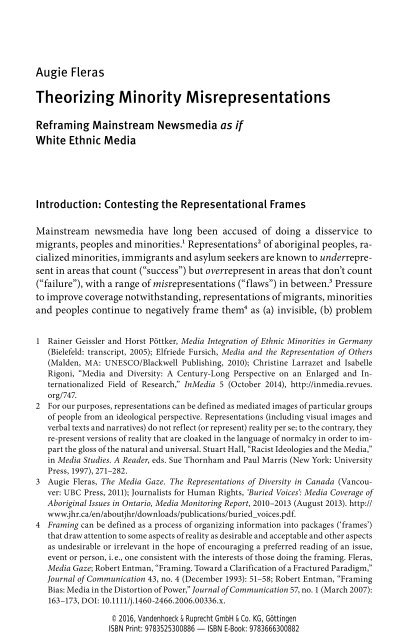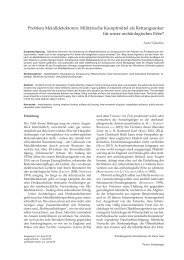Media and Minorities
9783666300882_ruhrmann_media_ebook_034247
9783666300882_ruhrmann_media_ebook_034247
You also want an ePaper? Increase the reach of your titles
YUMPU automatically turns print PDFs into web optimized ePapers that Google loves.
Augie Fleras<br />
Theorizing Minority Misrepresentations<br />
Reframing Mainstream Newsmedia as if<br />
White Ethnic <strong>Media</strong><br />
Introduction: Contesting the Representational Frames<br />
Mainstream newsmedia have long been accused of doing a disservice to<br />
migrants, peoples <strong>and</strong> minorities.1 Representations2 of aboriginal peoples, racialized<br />
minorities, immigrants <strong>and</strong> asylum seekers are known to underrepresent<br />
in areas that count (“success”) but overrepresent in areas that don’t count<br />
(“failure”), with a range of misrepresentations (“flaws”) in between.3 Pressure<br />
to improve coverage notwithst<strong>and</strong>ing, representations of migrants, minorities<br />
<strong>and</strong> peoples continue to negatively frame them4 as (a) invisible, (b) problem<br />
1 Rainer Geissler <strong>and</strong> Horst Pöttker, <strong>Media</strong> Integration of Ethnic <strong>Minorities</strong> in Germany<br />
(Bielefeld: transcript, 2005); Elfriede Fursich, <strong>Media</strong> <strong>and</strong> the Representation of Others<br />
(Malden, MA: UNESCO/Blackwell Publishing, 2010); Christine Larrazet <strong>and</strong> Isabelle<br />
Rigoni, “<strong>Media</strong> <strong>and</strong> Diversity: A Century-Long Perspective on an Enlarged <strong>and</strong> Internationalized<br />
Field of Research,” In<strong>Media</strong> 5 (October 2014), http://inmedia.revues.<br />
org/747.<br />
2 For our purposes, representations can be defined as mediated images of particular groups<br />
of people from an ideological perspective. Representations (including visual images <strong>and</strong><br />
verbal texts <strong>and</strong> narratives) do not reflect (or represent) reality per se; to the contrary, they<br />
re-present versions of reality that are cloaked in the language of normalcy in order to impart<br />
the gloss of the natural <strong>and</strong> universal. Stuart Hall, “Racist Ideologies <strong>and</strong> the <strong>Media</strong>,”<br />
in <strong>Media</strong> Studies. A Reader, eds. Sue Thornham <strong>and</strong> Paul Marris (New York: University<br />
Press, 1997), 271–282.<br />
3 Augie Fleras, The <strong>Media</strong> Gaze. The Representations of Diversity in Canada (Vancouver:<br />
UBC Press, 2011); Journalists for Human Rights, ‘Buried Voices’: <strong>Media</strong> Coverage of<br />
Aboriginal Issues in Ontario, <strong>Media</strong> Monitoring Report, 2010–2013 (August 2013). http://<br />
www.jhr.ca/en/aboutjhr/downloads/publications/buried_voices.pdf.<br />
4 Framing can be defined as a process of organizing information into packages (‘frames’)<br />
that draw attention to some aspects of reality as desirable <strong>and</strong> acceptable <strong>and</strong> other aspects<br />
as undesirable or irrelevant in the hope of encouraging a preferred reading of an issue,<br />
event or person, i. e., one consistent with the interests of those doing the framing. Fleras,<br />
<strong>Media</strong> Gaze; Robert Entman, “Framing. Toward a Clarification of a Fractured Paradigm,”<br />
Journal of Communication 43, no. 4 (December 1993): 51–58; Robert Entman, “Framing<br />
Bias: <strong>Media</strong> in the Distortion of Power,” Journal of Communication 57, no. 1 (March 2007):<br />
163–173, DOI: 10.1111/j.1460-2466.2006.00336.x.<br />
© 2016, V<strong>and</strong>enhoeck & Ruprecht GmbH & Co. KG, Göttingen<br />
ISBN Print: 9783525300886 — ISBN E-Book: 9783666300882







